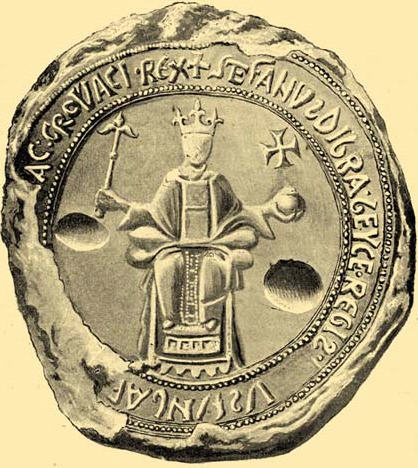Felicia of Sicily on:
[Wikipedia]
[Google]
[Amazon]
 Felicia of SicilyShe’s called ''Felícia'' in Hungarian. (c. 1078—c. 1102) is a name used for one Queen consort of Hungary and Croatia.
She was daughter of Count
Felicia of SicilyShe’s called ''Felícia'' in Hungarian. (c. 1078—c. 1102) is a name used for one Queen consort of Hungary and Croatia.
She was daughter of Count
 Felicia of SicilyShe’s called ''Felícia'' in Hungarian. (c. 1078—c. 1102) is a name used for one Queen consort of Hungary and Croatia.
She was daughter of Count
Felicia of SicilyShe’s called ''Felícia'' in Hungarian. (c. 1078—c. 1102) is a name used for one Queen consort of Hungary and Croatia.
She was daughter of Count Roger I of Sicily
Roger I ( it, Ruggero I, Arabic: ''رُجار'', ''Rujār''; Maltese: ''Ruġġieru'', – 22 June 1101), nicknamed Roger Bosso and The Great, was a Norman nobleman who became the first Count of Sicily from 1071 to 1101. He was a member of the ...
and his second wife, Eremburga of Mortain Eremburga of Mortain (Eremburge de Mortain) was the second wife of Count Roger I of Sicily and thus the second Sicilian countess. She is very obscure and details of her life are almost unknown to us today.
Her father was either William, Count of ...
. She is also called Busilla, but this name is a misunderstanding of the ancient Italian
Italian(s) may refer to:
* Anything of, from, or related to the people of Italy over the centuries
** Italians, an ethnic group or simply a citizen of the Italian Republic or Italian Kingdom
** Italian language, a Romance language
*** Regional Ita ...
word ''pucelle'' meaning "virgin".
Coloman, King of Hungary
Coloman the Learned, also the Book-Lover or the Bookish ( hu, Könyves Kálmán; hr, Koloman; sk, Koloman Učený; 10703February 1116) was King of Hungary from 1095 and King of Croatia from 1097 until his death. Because Coloman and his younge ...
sent his envoys to her father's court to propose marriage to her in 1096, but the Count of Sicily did not qualify the envoys illustrious enough and refused the offer. The second mission of the King of Hungary was led by Bishop Hartvik
Hartvik (''Arduin'') was a prelate (most probably the bishop of Győr) in the Kingdom of Hungary under King Coloman the Book-lover. He wrote a new ''Life'' of St Stephen I of Hungary
Stephen I, also known as King Saint Stephen ( hu, Szent Is ...
, but insisted on further negotiations. Finally, the envoys, led by Prince Álmos
Álmos (also "Almus", Slovak, hr, Almoš; 1070 or 1075 – 1 September 1127) was a Hungarian prince, the son of King Géza I of Hungary and brother of King Coloman. He held several governmental posts in the Kingdom of Hungary.
Life
Ea ...
,
accompanied Felicia to Hungary, where she was married to Coloman Coloman, es, Colomán (german: Koloman (also Slovak, Czech, Croatian), it, Colomanno, ca, Colomà; hu, Kálmán)
The Germanic origin name Coloman used by Germans since the 9th century.
* Coloman, King of Hungary
* Coloman of Galicia-Lodomeria ...
around 1097.
She was followed by some Sicilian courtiers as well, ''e.g.'' the ancestors of the future ''gens'' Rátót (Olivér and Rátót) who arrived to Hungary
Hungary ( hu, Magyarország ) is a landlocked country in Central Europe. Spanning of the Pannonian Basin, Carpathian Basin, it is bordered by Slovakia to the north, Ukraine to the northeast, Romania to the east and southeast, Serbia to the ...
in her escort.
Marriage and children
''# c. 1097:'' KingColoman of Hungary
Coloman the Learned, also the Book-Lover or the Bookish ( hu, Könyves Kálmán; hr, Koloman; sk, Koloman Učený; 10703February 1116) was King of Hungary from 1095 and King of Croatia from 1097 until his death. Because Coloman and his younge ...
(c. 1070 – 3 February 1116)
* Sophia (before 1101 – ?), wife of a Hungarian noble
* King Stephen II of Hungary (1101 – 1 March 1131)
* Ladislaus (?)
Notes and references
Sources
* Soltész, István: ''Árpád-házi királynék'' (Gabo, 1999) * Kristó, Gyula - Makk, Ferenc: ''Az Árpád-ház uralkodói'' (IPC Könyvek, 1996) {{DEFAULTSORT:Felicia Of Sicily Hungarian queens consort Italo-Normans Sicilian people of Norman descent Burials at the Basilica of the Assumption of the Blessed Virgin Mary Burials at St. Michael's Cathedral, Alba Iulia 11th-century Hungarian women 12th-century Hungarian people 12th-century Hungarian women 11th-century Italian nobility 11th-century Italian women 1070s births 1100s deaths